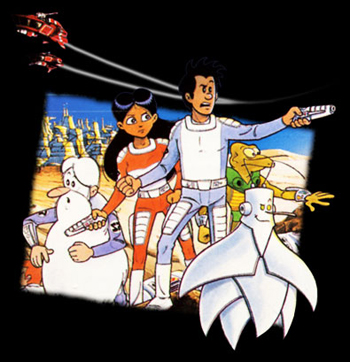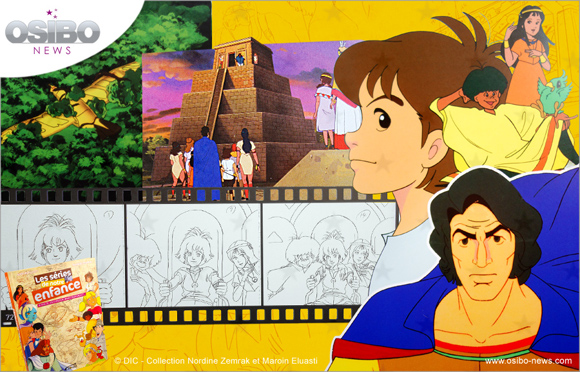That is history according to tin foil head, here, or Youtube.
There are two kinds of science fiction; what comes before the moon landing and what comes after. Before 1968, like with Planet of the Apes and 2001 Space Odyssey, what is "out there" was a question that haunted adults, with the Space Race and the Cold War raising lots questions about humans and their place in time and space, the dawn of mankind and the end of the World. Hence the Ancient Alien theory that got History TV many ratings. 2001 Space Odyssey got it just right. No attempts to draw aliens curiousily like us even though they are from another World, just those enigmatic monoliths that taught the first humans how to use weapons. 2001 does not say much, but that may be one of its strengts. In art, the only way to show the unknown is to show it as little as possible. To stay mysterious.
After 1969, the major works in science fiction are blockbusters made for children; E.T., Star Wars...one TV series I grew up with that did not dumb down anything was "Once Upon a Time...Space", made in 1982. It is a children's series, with laser guns and travel at the speed of light but it also has Métro, a little robot that can talk about Schopenhauer or Nietzche while observing an ant colony from the inside, philosophizing on how things can be like an ant colony; many bodies but only one mind. There are episodes about the Greek mythology, Atlantis...the characters constantly visit planets that are a lot like prehistorical earth and in more then one occasion, they are mistaken for Gods. In the last few episodes of the series, a race of robots try to take over humans on the terms that they are foolproof, superior to humans (a bit like HAL in 2001), mysterious beings of light come to save the humans from the robots, not unlike they, themselves, did to more than one prehistoric planet.
1968 was also the year of the Tintin book "Flight 714". My favorite in the series. Once again, the aliens are never seen in the book. We barely see a flying saucer. but we do see an old temple, filled with statues depicting aliens and meet an telepathic "ambassador" who meets the aliens on a frequent basis. The flying saucer comes in just in time to save the characters from a volcanic eruption. It all started with a kidnapping but in the end, the kidnappers themselves get...abducted.
Another cool tv series with ancient aliens was "The Mysterious Cities of Gold". Even though aliens are never explicitly mentionned, the lost continents of Mu and Atlantis are. The series starts as purely historical, with the main characters leaving Barcelona for newly-discovered Peru. It includes several historical conquistadores like Pizzaro and La Malinche and although it is a kids' tv series, it is a strong reminder to many a canadian kid that our country, too has a very heavy history with its first cultures.
Then, there is the "underworld" of the series. In almost every episode the characters explore a cave, an ancient temple and find something completely insane like a flying golden airplane shaped like a condor, a solar boat or a jade mask. All examples of the lost wisdom of the ancients. That's how we discover the Olmecs. It is the name given to an actual pre-colombian civilization but in this series, there are a race of alien-like old men who need the cells of young ones to go on living. Even though they are never mentionned as actual aliens, they have the appearance, evilness and technology we usually associate with them.
The soundtrack of this series is just plain superb and there is a little five-minute live-action doc about pre-columbian America at the end of every episode
***
Now row two has nothing to do with ancient aliens, but another favorite of the conspiracy theorist scene, the Templars. They guarded the pilgrims in the Holy Land, became very wealthy and after the Crusades were over, the king of France, Philippe the Bold, had them burned alive.
One of the best works of fiction I've ever read/watched on that was Les Rois Maudits, a historical novel written by Maurice Druon. It is almost 2000 pages long, but it was adapted to tv in 1972...
...and in 2005, starring Gérard as the Grand Templar Master himself as well as every Depardieu at hand:
In his work, Druon popularizes the legend saying that just before he died in the flames, Jacques de Molay cursed the Pope and the King for 13 generations. The pope died within a month and the capetian dynasty was extinct within 20 years, or two generations.
There goes your thirteen generations of cursed ones but in 1789, when the king of France had bigger problems than just a curse, one of the places where Marie-Antoinette and Louis XVI were held was "The Temple", an old Templar fortress...that's how legends are born!
Truth is, according to Druon's book, it was not a curse that got the best of the last capetian kings, but the passionate hatred between Mahaut of Artois (old lady in dark purple) and Robert of Artois (in red). Between the two of them, they caused the disgraces of the princesses of France, then murdered one of them (Robert), they killed Philip IV's successor Louis XI, and his infant son (Mahaut) and then coaxed Edward III of England to invade France, starting the Hundred Years' war just to get their hands on (or keep) a little piece of land in Belgium called Artois.
Those two were a curse of their own.
They are also a major point against those who think "the powerful" form a monolithic block bent on oppressing the people. You think powerful people don't have greed? That they don't fight one another? Think again.






